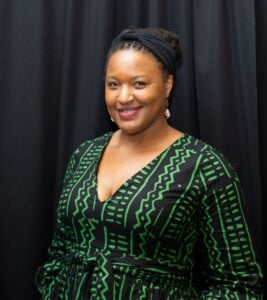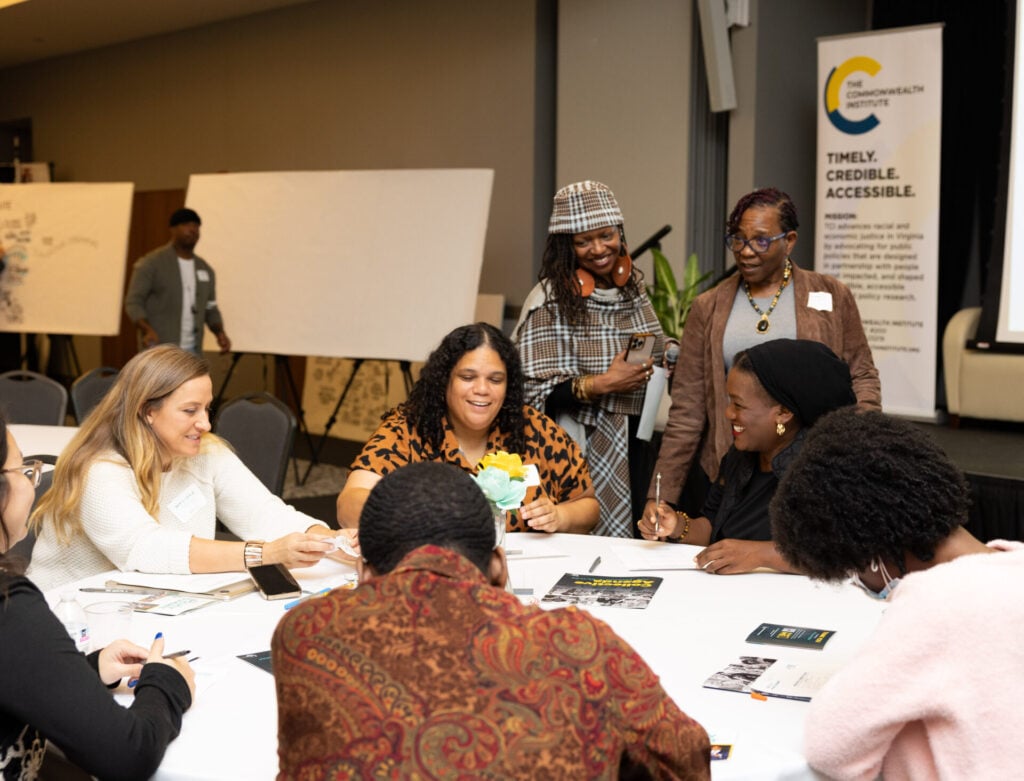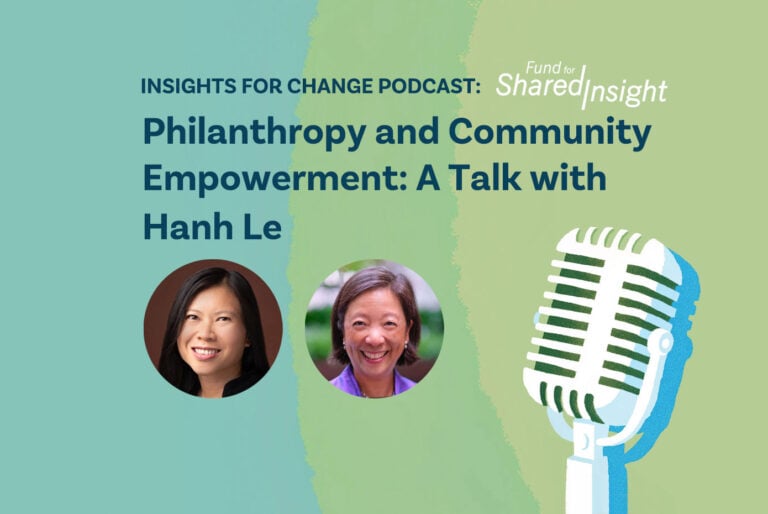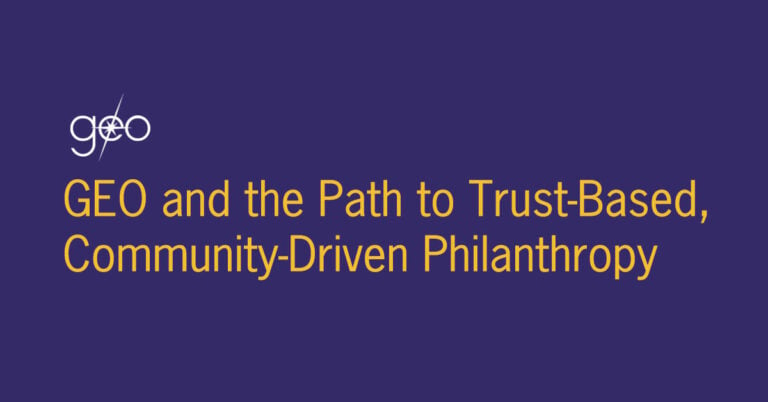Ashley Kenneth is president and CEO of The Commonwealth Institute (TCI), a state-level policy organization working to advance racial and economic justice in Virginia. Her experiences growing up with civic-minded parents and being one of only a few Black students at the private school she attended “activated” her, she says, “to go into social change as a career.” She has helped lead the charge in recent years for TCI to apply a clear racial equity lens to its work and to ensure that those most impacted by policy change are included in advocacy and decision making — what she calls people-powered policy.
Fund for Shared Insight spoke with Kenneth about how advocacy and policy organizations, and the funders who support them, can do a better job of listening and shifting power to the people and communities most impacted by their work. The following are excerpts from that discussion, edited for length and clarity.
Q: The Commonwealth Institute has undergone a major shift in recent years toward what you describe as “people-powered policy.” What sparked that transformation, and how has it changed your approach as an organization?
We’d already begun leaning into equity before 2020, working with consultants and setting up an equity leadership team. But that year marked a true shift. We created a new strategic plan that explicitly named racial equity as the core of our work — for the first time. And once we did that, we realized we couldn’t keep operating the same way.
We could no longer be the policy shop on the hill that just puts out white papers and identifies solutions in-house. If racial equity was going to be the foundation of our work, we had to operate differently. That meant listening to the people most impacted by policy decisions — not just talking about them, but building real relationships and sharing power.
That decision changed us. It changed our partners. And it’s changing the work itself. Listening and engaging with community aren’t add-ons anymore. That is the work.
Listening and engaging with community aren’t add-ons anymore. That is the work.
Q: How did TCI deepen its community engagement, and what kinds of insights or changes have emerged from that process?
Before, we mostly engaged with other advocacy organizations — state-level partners. Grass tops, not grassroots. We didn’t have members or regular meetings with community groups. We relied on our partners to do that part of the work.
Now, we’ve said: we still need to talk to our partners, but we also need to be in relationship with directly impacted people ourselves. That’s why we created Collective Work, a coalition of 12 Black and brown leaders from across Virginia who are doing direct service work in their communities.
These are grassroots leaders — people who are listening, learning, and leading every day. They care about policy, but they might not have the connections or training to plug into it. That’s where we come in. We act as a bridge. We also make sure they’re compensated for their time, because we value what they bring.
Some of the issues we work on together are familiar, but we now approach them differently because we’re hearing real stories. One issue they surfaced was “safer communities.” They were excited about it and saw it as a top priority. For them, safer communities was about resources for youth, access to opportunity, and a sense of belonging. That wasn’t something we’d worked on before, and we had to start by asking: What does that mean? It wasn’t an area where we had capacity or expertise, but we made it part of our Collective Agenda, our policy agenda, which is based in part on conversations with community leaders. We’ve begun tracking state budget funding related to youth safety programs and connecting coalition members with organizations doing that work.
Q: How do you define people-centered policy?
To me, people-centered policy isn’t just designed for the people it’s meant to help — it’s designed with them. That’s a huge difference.
The people most affected by a policy should be at the decision-making table. Their input should be heard, valued, and reflected in the outcome. When we don’t include those voices, we miss critical insights. And too often, those are the people who’ve been historically left out — Black and brown communities, low-income families, immigrants.
When we bring their voices in, the work becomes more grounded, more relevant, and more powerful. It’s not just about giving people a seat at the table. It’s about making sure they help set the agenda.
When we bring their voices in, the work becomes more grounded, more relevant, and more powerful. It’s not just about giving people a seat at the table. It’s about making sure they help set the agenda.
Q: What are you seeing from funders right now — what’s working, and what could be better when it comes to listening and engagement?
A lot of funders tend to show up and listen when there’s a crisis. Right now, many aren’t sure what to do with the political climate, so their instinct is to bring people together and say, “Y’all talk to each other.” And that kind of convening can be helpful — but it’s not enough.
It’s more effective when relationships are built over time. Without that, convenings feel awkward. You’re in a room with organizations you don’t really know, trying to have deep conversations without a foundation. It’s like, we don’t really have a relationship with you, but now we’re at this convening with other organizations we don’t know, and you’re asking us to have a meaningful conversation. It would be better if those relationships had been built over time.
Some funders are starting to move beyond just listening to grantees. They’re asking about Collective Work and wanting to engage with our community partners too, which I really appreciate. They just need a little extra support in figuring out how to do that well.
One thing that makes a big difference is showing up. Ricshawn Roane at the Weissberg Foundation is an example of someone who does this — she comes to our events, not as a funder above the room, but as part of the conversation. Just having conversations with folks, being in the space, not acting like there’s a hierarchy. Our annual policy summit has become more community-oriented each year. It’s not just folks in suits anymore. We have spoken word artists, volunteers, community leaders. Last year we hosted a visioning session where people designed the Virginia they want for their families and communities. We put it all up on big boards. It was beautiful. Just asking folks to design the Virginia they want to see for themselves and their families—those boards were powerful. And to have a funder in the room to witness that, it meant something.
Q: What happens after funders listen? What does real power-sharing look like in practice?
That’s the part we often don’t see. A funder convenes a conversation and gathers insights — but then what? As grantees, we’re left wondering: What are you doing with this information? How are you using it to move the work forward?
If you’re going to bring people together to share what they’re seeing and experiencing, there has to be a next step. Otherwise, it can feel like extraction.
Power-sharing means more than listening. It means being clear about what comes next. Will there be continued engagement? Will community input actually influence funding strategies or program design? When funders gather insights and make decisions behind closed doors, that’s not shifting power. That’s holding onto it.
Q: If you had the floor in a room full of funders, what would you most want them to hear about how to support community-driven change?
I’d say this: Listening isn’t just a step on the path to change. It is the work.
If we’re serious about equity, about transforming systems, then listening to community can’t be treated like a checkbox. It has to be central. At TCI, that shift has changed everything. It’s changed how we operate, who we work with, and what we prioritize.
And I’m often struck by how much it means to people when we open the door. When a community partner thanks me for inviting them to speak, or for connecting them with a funder, I’m honestly surprised — because that’s just how the work should be done. That’s what advocacy should look like. It shouldn’t be rare. It should be the norm that people closest to the issues are at the center of the work.
Listening isn’t a tactic. It’s not a one-time event. It’s an ongoing practice. And if we’re really trying to build a more just and equitable world, that’s where the work begins — and where it has to stay. And I think that’s the shift organizations and funders really need to make — seeing listening not as a means to an end, but as the actual work of justice.
A Fund for Shared Insight Q & A with:









